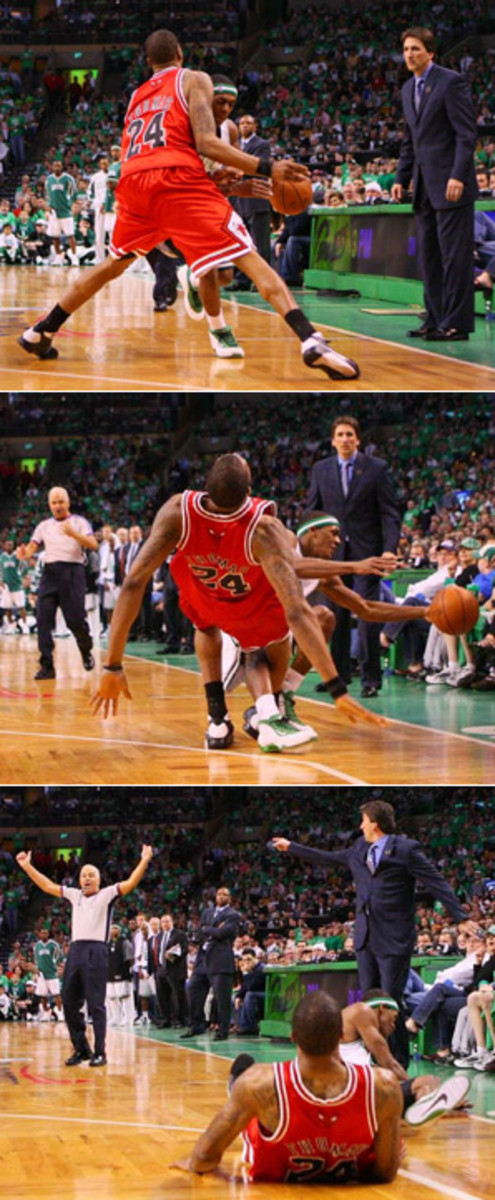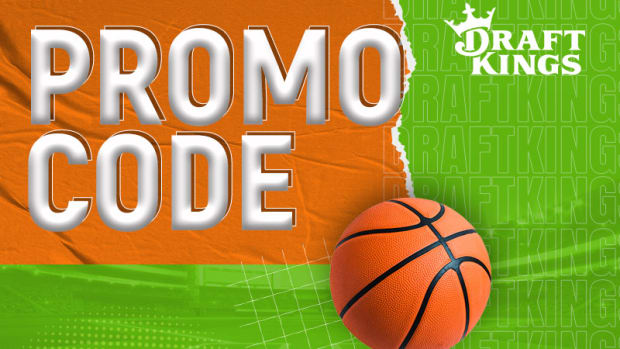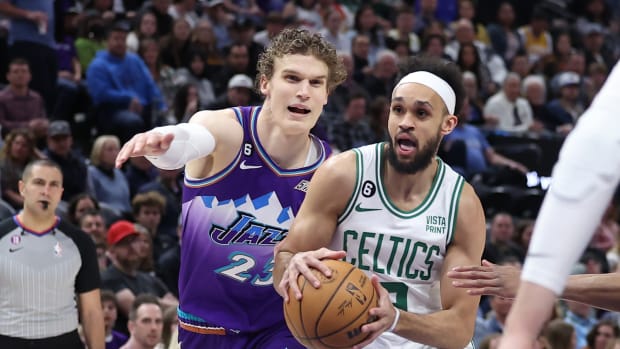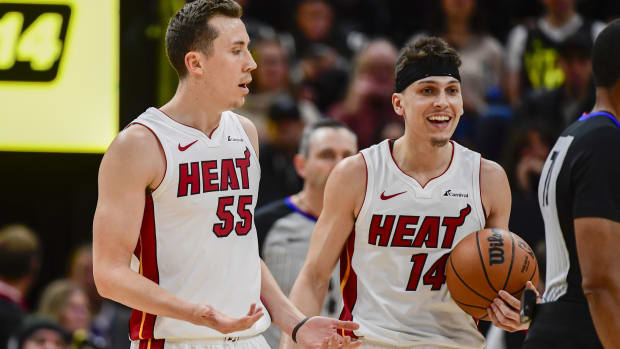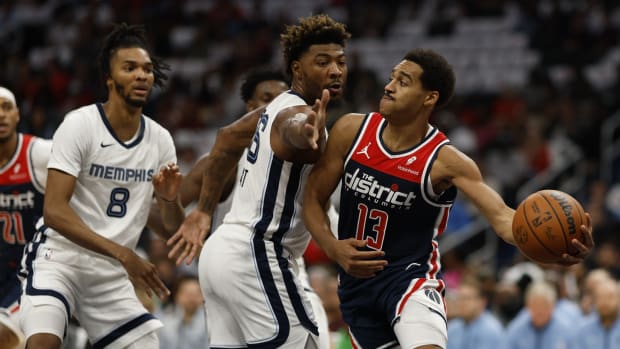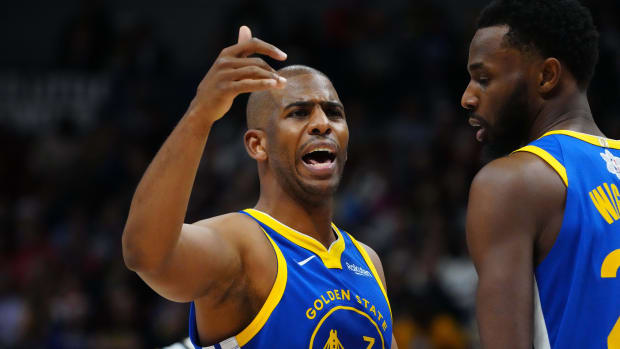The toughest call: Block or charge?
This story appears in the April 27, 2009 issue of Sports Illustrated.
At this time of year James Posey walks barefoot across the locker room carpet with a tentative hobble. If crash-test dummies could unbuckle their own seat belts, they would stagger away from accident scenes much like the 32-year-old Posey has after some of his recent playoff games -- bent severely at the hips, trying not to aggravate the aches that already cause his lips to purse. Yet this is the time of year that Posey loves more than any other.
Because this is when he matters most, even if it almost kills him.
Posey has become expert in both pain management and championship celebrations because he is among the best in the league at drawing charges. When the Hornets' forward sees an opponent driving to the basket, he turns into a 6' 8" Mahatma Gandhi with a headband. Leaving his own man unguarded, he scurries to the top of the semicircle under the basket, faces his enemy and stands in nonviolent protest of the punishment that awaits him.
Over his 10-year career with six NBA teams, Posey has averaged a negligible 9.2 points and 4.9 rebounds. But his sacrificial approach to defense contributed mightily to two recent championships -- with the Miami Heat in 2005-06 and last season with the Boston Celtics -- and persuaded New Orleans to sign him last summer for $25 million over four years. Posey routinely dives chin-first for loose balls, wrestles through screens and bodies up against larger opponents, but it is his talent for drawing charges that defines his value to New Orleans.
The risks of the most selfless deed in basketball, though, go beyond the physical. That's because the often-fractional difference between a charge and a block call is decided by a referee who has to determine, in a split second: a) were the defender's feet set, b) was he outside the court's semicircle, c) who initiated contact, and d) does the contact merit a call at all? What's really cruel is that despite Posey's skill, anticipation and sacrifice, he could very easily send the player who ran him down to the free throw line. Which can make those postgame walks across the locker room carpet ever more painful.
As defenses tighten and All-Stars attack the hoop recklessly over the weeks of playoffs ahead, the block/ charge call will inevitably make its presence felt as the least understood and most infuriating symbol of postseason intensity. The hunger to attack and defend the paint leads to familiar arguments over who was there first: a violent crash, the whistle, two or more sneakered survivors lying askew and thousands of biased eyewitnesses awaiting justice. While a bang-bang out-of-bounds play might equally test an official's reflexes, the block/charge ruling can result in a personal foul and points, not just possession. "It's an incredibly difficult play to call," says Nuggets coach George Karl. "I could put 20 on tape that everybody would miss. Some you would call charge, some you would call block. They're that close -- where the offense has the right to the territory and where the defense has the right to the territory, it's a very thin line."
That line is one that some of the biggest NBA names love to dance along. When LeBron James, Kobe Bryant or Dwyane Wade need points in crunch time, where do they go? They take the ball inside, confident that the whistles will blow their way and free throws will follow. Wade's ability to get the favorable side of the block/charge call was key to the Heat's beating the Mavericks in the 2006 Finals. "Who's charging who?" says Trail Blazers forward Channing Frye. "If it's LeBron versus any other dude, they're not going to give [the defender] the call. They want to keep [LeBron] in the game, or at least they'll give him a break." Also, Frye says, refs almost automatically award foul shots to quick guards like Tony Parker and Chris Paul on the assumption that they must have beat the defender to the spot. Of course, a reputation as a charge taker can come in handy too. "If you're a good help defender," says Frye, "90 percent of the time you're going to get the charge call."
Bernie Fryer, the NBA director of officials, cries foul at the notion of star treatment. Against the vast weight of anecdotal evidence, Fryer insists that the relative status of players has no influence on a call. The NBA's grading system ultimately decides which referees work in the playoffs and earn extra money, Fryer argues, so it's in the refs' best interest to get the block/charge right, whether it's LeBron James or Jerome James barreling to the hoop. In an attempt to quell the controversy around block/charge rulings, Fryer recently invited a reporter to his office to view replays of 13 calls. A difficult one from last season showed Miami guard Smush Parker driving around the Knicks' Renaldo Balkman and straight into a suddenly appearing Jared Jeffries. In slow motion you can see that Jeffries gets position, but in real time the players seem to arrive at the same moment. "In the old days you know what [prominent former refs] Joe Gushue or Jake O'Donnell would call?" says Fryer, breaking into a smile. He rotates his forearms, the signal for traveling. "Because he didn't know," says Fryer. "He didn't know, so he'd say, He must have walked."
Back then, every official had his own view of what constituted a charge, in much the same way that each umpire applies his own strike zone to a baseball game. The availability of video has resulted in a more uniform standard in the NBA: Referees study up to three hours of block/charge plays at their six-day preseason camp in Jersey City, and throughout the season they refer to the league's online "video rule book," which is constantly updated with plays that illustrate the right and wrong way to make each call -- an indication of the ever-changing variables at work. "We have a lot of these in our game now, we call them 'passes and crashes,' " says Fryer, playing and replaying a video from last season of Magic forwardRashard Lewis, after dishing the ball, leveling Cavaliers guard Shannon Brown in the lane for a charge. "His momentum carries him into the defender," Fryer says. "In the old days we may lay off that play [and make no call], but it's getting to be [like a] train wreck, so we say, What's the call? It's an offensive foul."
Today it is far easier to draw a charge than when Fryer began officiating games in the late 1970s. It used to be that if a defender flinched at all before drawing contact, he was called for a blocking foul. By today's standard upper-body movement is largely irrelevant: The key to drawing a charge in the lane now is to have the feet set before the driver takes his last doomed step. Of course the defender has to be outside the dotted semicircle, which was added in 1997 -- though if he's inside the half-moon, he can at least avoid a blocking foul by jumping straight up with arms high. In such a case the driver could even be called for an offensive foul if he causes excessive contact. Are you starting to see why players, let alone fans, might be confused? "This [interpretation] is hugely misunderstood," says Fryer, who acknowledges that Cavs forward Anderson Varejão is among the best at avoiding or drawing fouls while in the semicircle. "He really works at it. Even though he flops a lot, he's still very good at getting into the defensive position and knowing when to go vertical."
It's Varejão, the 6' 11" forward-center of top-seeded Cleveland, who is most likely to be in the middle of a charge call that inspires exasperation from players and opposing fans. Among players in this postseason, Varejão was the regular-season leader in offensive fouls drawn, with 52. The Cavaliers ranked No. 1 in defensive field goal percentage and points allowed, and much of the credit belongs to their astute defensive switches, which often culminated in their friendly 26-year-old Brazilian lying back-down on the floor. "It's inspirational to me when Andy puts his body on the line and takes charges," says Cavs coach Mike Brown. "He's not afraid to take one across the chops either. He'll know that it's our ball going the other way."
Lockdown teams like the Cavaliers and the Celtics emphasize the importance of bodily sacrifice: Their well-practiced rotations liberate Varejão or Boston's Glen (Big Baby) Davis to seek a charge, knowing that a teammate will shift over and cover his man. "Our defense is about getting our body to the spot," says Boston coach Doc Rivers, who used to give $100 cash bonuses for each drawn charge when he was running Orlando. (The league has since outlawed the practice as a salary-cap violation.) "When you're a great help defensive team, [opponents] know -- even if it's not a charge -- that somebody's going to be there and it's going to be physical."
A generation ago defenders protected the basket by delivering hard fouls. "It used to be, Hey, suck it up, get that blood off the floor, and let's shoot free throws," recalls Rockets guard Brent Barry, 37. But since 1993 the league has suppressed its thuggish image by giving flagrant fouls and suspensions to overly aggressive defenders. So in this generation the new villain becomes a player like Varejão -- who by the traditional standards of Bill Laimbeer or Bruce Bowen isn't villainous at all. If anything, he should be pitied, like one of those destitute souls who runs in front of moving cars for the insurance money. "Sometimes I hear I'm a dirty player, he's going to flop, whatever," says Varejão. "But you can see I never hit nobody. I just look for a way to be important to my team."
And so what if, to make his importance stand out, he has to go to the floor sometimes? As the late Johnnie Cochran might have put it, if he doesn't fall, he won't get the call. Varejão has been drawing charges since he was a skinny teenager playing with grizzled pros in the Brazilian league -- the age when he unwittingly gained an advantage by growing out his dreadlocks to their current Sideshow Bob length. Now his hair splashes out with each flop to emphasize the punishment he is absorbing.
If the Cavaliers advance as expected to the second round, they could find themselves facing the Heat -- a series that would put even the best ref's skills to the test. You would have Varejão stepping into the lane to draw charges on the relentlessly penetrating Wade, who led all guards in free throw attempts this season, with 9.8 per game. Wade has his own take on those collisions under the hoop. For all of the preferential treatment he is accused of receiving, he believes he earns his whistles. Especially when he's more horizontal than vertical after launching knee-high into the chest of a defender who appeared out of nowhere, like a deer on the highway. "You're up high, and it's a long way down," says Wade. "When you get hit, you know this is going to be a bad one right here."
And so he waits for the crash to the floor. And then, he hopes, a free throw or two.






























